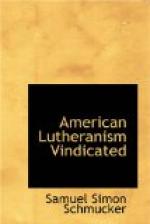Again, “Baptism is the first gateway of grace, the sacrament of initiation: the Lord’s Supper is the sacrament of confirmation; by baptism we are regenerated, by the Holy Supper we are nourished and strengthened to eternal life. As in nature so in grace, we are first born and then fed, first generated and then we increase, (ix. 67.) Dr. Buddeus, one of the most distinguished theologians of the School of Halle, in his “Theologia Dogmatica, [sic on punctuation] p. 1127, says, “The design of the baptism of infants is their regeneration; in the case of adults, the confirmation and sealing of that faith, which they should have before (the reception of the rite.”)
Since therefore we have seen that the doctrine of baptismal regeneration was taught not only by the symbolical books, but also by Luther and Melancthon in their other writings, as well as by the leading divines of the first two centuries after the Reformation, who all received the symbolical books, and understood their import, we may regard the charge of the Platform as established beyond contradiction, that this tenet was a part of Symbolic Lutheranism.
Influence of this Doctrine on the Pulpit.
Now the influence of this doctrine on the ministrations of the pulpit, is of the most deleterious nature. The word of God represents all mankind as by nature dead in trespasses and sins. Paul tells us that “there is none righteous, no not one, for all have sinned and come short of the glory of God:” and affirms that the carnal mind is enmity against God. The faithful ambassador of Christ must therefore announce the command of God, “that all men every where should repent: and that unless they do repent, they shall all likewise perish. He must divide his congregation into two classes, the friends and the enemies of God, those who are for the Saviour and those who are against him: and he must insist upon judging not by their profession, “Lord, Lord, but by the question, whether they do the will of our Father in heaven.” Thus when the faithful servant of Christ represents all as unconverted, and exposed to the curse of the divine law, who do not give evidence of regeneration in their walk and conversation; careless sinners become alarmed and feel the necessity of fleeing from the wrath to come, by repenting and turning to God, by seeking pardon and a new heart, and consecrating all their powers of mind and body to the service of God.
But all this the believer in baptismal regeneration cannot consistenly [sic] do. Because 1. If we believe all our hearers regenerated, (for they are generally all baptised) even those whose life presents not the least evidence of piety, and many proofs to the contrary; we still must believe them in some sense the children of God, as they are born again! We cannot tell them that they are in the gall of bitterness and bonds of iniquity; because we profess to believe them regenerated— therefore children of God in some sense.




